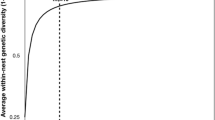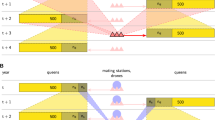Abstract
There have been numerous reports of genetic influences on division of labor in honey bee colonies, but the effects of worker genotypic diversity on colony behavior are unclear. We analyzed the effects of worker genotypic diversity on the phenotypes of honey bee colonies during a critical phase of colony development, the “nest initiation” phase. Five groups of colonies were studied (n = 5–11 per group); four groups had relatively low genotypic diversity compared to the fifth group. Colonies were derived from queens that were instrumentally inseminated with the semen of four different drones according to one of the following mating schemes: group A, 4 A-source drones; group B, 4 B-source drones; group C, 4 C-source drones; group D, 4 D-source drones; and group E, 1 drone of each of the A-D drone sources. There were significant differences between colonies in groups A-D for 8 out of 19 colony traits. Because the queens in all of these colonies were super sisters, the observed differences between groups were primarily a consequence of differences in worker genotypes. There were very few differences (2 out of 19 traits) between colonies with high worker genotypic diversity (group E) and those with low diversity (groups A-D combined). This is because colonies with greater diversity tended to have phenotypes that were average relative to colonies with low genotypic diversity. We hypothesize that the averaging effect of genotypic variability on colony phenotypes may have selective advantages, making colonies less likely to “fail” because of inappropriate colony responses to changing environmental conditions.
Similar content being viewed by others
References
Bailey L, Ball BV (1991) honey bee pathology. Academic Press, London
Breed MD, Robinson GE, Page RE (1990) Division of labor during honey bee colony defense. Behav Ecol Sociobiol 27:395–401
Calderone NW, Page RE (1988) Genotypic variability in age polyethism and task specialisation in the honey bee, Apis mellifera (Hymenoptera: Apidae). Behav Ecol Sociobiol 22:17–25
Calderone NW, Page RE (1991) The evolutionary genetics of division of labor in colonies of the honey bee (Apis mellifera). Am Nat 138:69–92
Calderone NW, Page RE (1992) Effects of interactions among genotypically diverse nestmates on task specialization by foraging honey bees (Apis mellifera). Behav Ecol Sociobiol 30:219–226
Calderone NW, Robinson GE, Page RE (1989) Genetic structure and division of labor in honeybee societies. Experientia 45: 765–767
Camazine S (1993) The regulation of pollen foraging by honey bees: how foragers assess the colony's need for pollen. Behav Ecol Sociobiol 32:265–272
Carlin NF, Reeve HK, Cover SP (1993) Kin discrimination and division of labor among matrilines in the polygynous carpenter ant, Camponotus planatus. In: Keller L (ed) queen number and sociality in insects. Oxford University Press, Oxford, pp 362–401
Cole BJ (1983) Multiple mating and the evolution of social behavior in the Hymenoptera. Behav Ecol Sociobiol 12:191–201
Collins AM (1986) Bidirectional selection for colony defense in Africanized honey bees. Am Bee J 126:827–828
Collins AM, Rinderer TE, Harbo JR, Bolton AB (1982) Colony defense by Africanized and European honey bees. Science 218: 72–74
Collins AM, Rinderer TE, Harbo JR, Brown MA (1984) Heritabilities and correlations for several characters in the honey bee. J Hered 75:135–140
Collins AM, Rinderer TE, Tucker K (1988) Colony defence of two honeybee types and their hybrids. I. Naturally mated queens. J Apic Res 27:137–140
Crozier RH, Consul PC (1976) Conditions for genetic polymorphisms in social Hymenoptera under selection at the colony level. Theor Popul Biol 10:1–9
Crozier RH, Page RE (1985) On being the right size: male contributions and multiple mating in social Hymenoptera. Behav Ecol Sociobiol 18:105–115
Fewell JH, Page RE (1993) Genotypic variation in foraging responses to environmental stimuli by honey bees, Apis mellifera. Experientia 49:1106–1112
Fewell JH, Winston ML (1992) Colony state and regulation of pollen foraging in the honey bee, Apis mellifera L. Behav Ecol Sociobiol 30:387–394
Frumhoff PC, Baker J (1988) A genetic component to division of labour within honey bee colonies. Nature 333:358–361
Fuchs S, Schade V (1994) Lower performance in honeybee colonies of uniform paternity. Apidologie 25:155–168
Gary NE, Lorenzen K (1984) Improved trap to recover dead and abnormal honey bees (Hymenoptera: Apidae) from hives. J Econ Entomol 13:718–723
Gilliam M, Taber S, Richardson GV (1984) Hygienic behavior of honey bees in relation to chalkbrood disease. Apidologie 14: 29–39
Giray T, Robinson GE (1994) Genetic variability for behavioral development and plasticity of age polyethism in honey bee colonies. Behav Ecol Sociobiol 35:13–20
Guzmán-Novoa E, Page RE (1993) Backcrossing Africanized honey bee queens to European drones reduces colony defensive behavior. Ann Entomol Soc Am 86:352–355
Guzmán-Novoa E, Page RE (1994) Genetic dominance and worker interactions affect honey bee colony defense. Behav Ecol 5:91–97
Guzmán-Novoa E, Page RE, Gary NE (1994) Behavioral and life history components of division of labor in honey bees (Apis mellifera L.). Behav Ecol Sociobiol 34:409–417
Kauffeld N (1975) Overwintering of colonies of honey bees with restricted and unrestricted broodrearing in Louisiana. Am Bee J 115:480–481, 490
Kauffman SA (1991) Antichaos and adaptation. Sci Am 265:78–84
Keller L, Reeve HK (1994) Genetic variability, queen number, and polyandry in social Hymenoptera. Evolution 48:694–704
Kolmes SA, Winston ML, Fergusson LA (1989) The division of labor among worker honey bees (Hymenoptera: Apidae): the effects of multiple patrilines. J Kans Entomol Soc 62:80–95
Moritz RFA, Hillesheim E (1985) Inheritance of dominance in honey bees (Apis mellifera capensis Esch.). Behav Ecol Sociobiol 17:87–89
Moritz RFA, Southwick EE (1987) Phenotype interactions in group behavior of honey bee workers (Apis mellifera L.). Behav Ecol Sociobiol 21:53–57
Moritz RFA, Southwick EE (1993) Bees as superorganisms: an evolutionary reality. Springer, Berlin Heidelberg New York
Oldroyd BP, Rinderer TE, Buco SM (1992a) Intra-colonial foraging specialism by honey bees (Apis mellifera). Behav Ecol Sociobiol 30:291–295
Oldroyd BP, Rinderer TE, Harbo JR, Buco SM (1992b) Effects of intracolonial genetic diversity on honey bee (Hymenopotera: Apidae) colony performance. Ann Entomol Soc Am 85:335–343
Oldroyd BP, Rinderer TE, Buco SM, Beaman LD (1993) Genetic variance in honey bees for preferred foraging distance. Anim Behav 45:323–332
Oldroyd BP, Sylvester HA, Wongsiri S, Rinderer TE (1994) Task specialization in a wild bee, Apis florea (Hymenoptera: Apidae), revealed by RFLP banding. Behav Ecol Sociobiol 34:25–30
Page RE (1980) The evolution of multiple mating behavior by honey bee queens (Apis mellifera L.). Genetics 96:263–273
Page RE, Laidlaw HH (1988) Full sisters and super sisters: a terminological paradigm. Anim Behav 36:944–945
Page RE, Metcalf RA (1984) A population investment sex ratio for the honey bee (Apis mellifera L.). Am Nat 124:680–702
Page RE, Mitchell SD (1991) Self organization and adaptation in social insects. In: Fine A, Forbes M, Wessels L (eds) PSA 1990 2. Philosophy of Science Association, East Lansing, Michigan, pp 289–298
Page RE, Robinson GE (1991) The genetics of division of labour in honey bee colonies. Adv Insect Physiol 23:118–169
Page RE, Robinson GE, Fondrk MK (1989) Genetic specialists, kin recognition, and nepotism in honey-bee colonies. Nature 338:576–579
Page RE, Robinson GE, Britton DS, Fondrk MK (1992) Genotypic variability for rates of development in worker honey bees (Apis mellifera). Behav Ecol 3:173–180
Page RE, Fondrk MK, Robinson GE (1993) Selectable components of sex allocation in colonies of the honey bee (Apis mellifera L.). Behav Ecol 4:239–245
Pamilo P, Crozier RH (1982) Measuring genetic relatedness in natural populations: methodology. Theor Popul Biol 21:171–193
Ratnieks FLW (1990) The evolution of polyandry by queens in social Hymenoptera: the significance of the timing of removal of diploid males. Behav Ecol Sociobiol 26:343–348
Robinson GE, Page RE (1988) Genetic determination of guarding and undertaking in honey-bee colonies. Nature 333:356–358
Robinson GE, Page RE (1989a) Genetic determination of nectar foraging, pollen foraging, and nest-site scouting in honey bee colonies. Behav Ecol Sociobiol 24:317–323
Robinson GE, Page RE (1989b) Genetic basis for division of labor in an insect society. In: Breed MD Breed, Page RE (eds), The genetics of social evolution. Westview Press, Boulder, pp. 61–80
Robinson GE, Page RE (in press) Genotypic constraints on plasticity for corpse removal in honey bee colonies. Anim Behav
Robinson GE, Page RE, Arensen N (1994) Genotypic differences in brood rearing in honey bee colonies: context-specific? Behav Ecol Sociobiol 34:125–137
Robinson GE, Page RE, Strambi C, Strambi A (1989) Hormonal and genetic control of behavioral integration in honey bee colonies. Science 246:109–112
Robinson GE, Page RE, Fondrk MK (1990) Intracolonial behavioral variation in worker oviposition, oophagy, and larval care in queenless honey bee colonies. Behav Ecol Sociobiol 26: 315–323
Rothenbuhler WC (1964) Behavioral genetics of nest cleaning in honey bees, IV. Responses of F2 and backcross generations to disease-killed brood. Am Zool 4:111–123
Sakagami S, Fukuda H (1968) Life tables for worker honeybees. Res Popul Ecol 10:127–139
Schmidt JO, Buchmann SL (1992) Other products of the hive. In: Graham JM (ed) The hive and the honey bee. Dadant, Hamilton, Illinois, pp. 927–988
Seeley TD (1982) Adaptive significance of the age polyethism schedule in honeybee colonies. Behav Ecol Sociobiol 11:287–293
Seeley TD (1985) Honeybee ecology: A study of adaptation in social life.Princeton University Press, Princeton
Seeley TD, Morse RA (1976) The nest of the honey bee (Apis mellifera L.). Insectes Soc 23:495–512
Seeley TD, Visscher PK (1985) Survival of honeybees in cold climates: the critical timing of colony growth and reproduction. Ecol Entomol 10:81–88
Sherman PW, Seeley TD, Reeve HK (1988) Parasites, pathogens, and polyandry in the social Hymenoptera. Am Nat 131:602–610
Snyder LE (1992) The genetics of social behavior in a polygynous ant. Naturwissenschaften 79:525–527
Sokal RR, Rohlf FJ (1981) Biometry Freeman, New York
Stort AC (1974) Genetic study of the aggressiveness of two subspecies of Apis mellifera in Brazil. I. Some tests to measure aggressiveness. J Apic Res 13:33–38
Stort AC (1975a) Genetic study of the aggressiveness of two subspecies of Apis mellifera in Brazil. II. Time at which the first sting reached the leather ball. J Apic Res 14:171–175
Stort AC (1975b) Genetic study of the aggressiveness of two subspecies of Apis mellifera in Brazil. IV. Number of stings in the gloves of the observer. Behav Genet 5:269–274
Stort AC (1975c) Genetic study of the aggressiveness of two subspecies of Apis mellifera in Brazil. V. Number of stings in the leather ball. J Kans Entomol Soc 48:381–387
Stuart RJ, Page RE (1991) Genetic component to division of labor among workers of a leptothoracine ant. Naturwissenschaften 78:375–377
Visscher PK (1983) The honey bee way of death: necrophoric behavior in Apis mellifera colonies. Anim Behav 31:1070–1076
Villa JD (1988) Defensive behaviour of Africanized and European honeybees at two elevations in Colombia. J Apic Res 27:141–145
Wilkinson L (1989) Systat: the system for statistics. Systat, Evanston
Winston ML (1980) Swarming, after swarming, and reproductive rate of unmanaged honeybee colonies (Apis mellifera). Insectes Soc 27:391–398
Winston ML (1987) The biology of the honey bee. Harvard University Press, Cambridge
Woyke J (1986) Sex determination. In: Rinderer TE (ed), Bee genetics and breeding, Academic Press, Orlando, pp 91–119
Author information
Authors and Affiliations
Additional information
Communicated by P. Pamilo
Rights and permissions
About this article
Cite this article
Page, R.E., Robinson, G.E., Fondrk, M.K. et al. Effects of worker genotypic diversity on honey bee colony development and behavior (Apis mellifera L.). Behav Ecol Sociobiol 36, 387–396 (1995). https://doi.org/10.1007/BF00177334
Received:
Accepted:
Issue Date:
DOI: https://doi.org/10.1007/BF00177334




